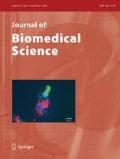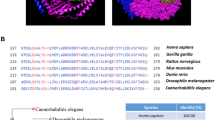Abstract
The multidrug resistance-associated protein (MRP) subfamily transporters associated with anticancer drug efflux are attributed to the multidrug-resistance of cancer cells. The genomic organization of human multidrug resistance-associated protein 7 (MRP7) was identified. The humanMRP7 gene, consisting of 22 exons and 21 introns, greatly differs from other members of the human MRP subfamily. A splicing variant of humanMRP7, MRP7A, expressed in most human tissues, was also characterized. The 1.93-kb promoter region ofMRP7 was isolated and shown to support luciferase activity at a level 4- to 5-fold greater than that of the SV40 promoter. BasalMRP7 gene expression was regulated by 2 regions in the 5′-flanking region at −1,780–1,287 bp, and at −611 to −208 bp. In Madin-Darby canine kidney (MDCK) cells, MRP7 promoter activity was increased by 226% by genotoxic 2-acetylaminofluorene and 347% by the histone deacetylase inhibitor, trichostatin A. The protein was expressed in the membrane fraction of transfected MDCK cells.
Similar content being viewed by others
References
Bakos E, Hegedus T, Hollo Z, Welker E, Tusnady GE, Zaman GJ, Flens MJ, Varadi A, Sarkadi B. Membrane topology and glycosylation of the human multidrug resistance-associated protein. J Biol Chem 271:12322–12326;1996.
Borst P, Evers R, Kool M, Wijnholds J. The multidrug resistance protein family. Biochim Biophys Acta 1461:347–357;1998.
Büchler M, Konig J, Brom M, Kartenbeck J, Spring H, Horie T, Keppler D. cDNA cloning of the hepatocyte canalicular isoform of the multidrug resistance protein, cMrp, reveals a novel conjugate export pump deficient in hyperbilirubinemic mutant rats. J Biol Chem 271:15091–15098;1996.
Cole SPC, Bhardwaj G, Gerlach JH, Mackie JE, Grant CE, Almquist KC, Stewart AJ, Kurz EU, Duncan AM, Deeley RG. Overexpression of a transporter gene in a multidrug-resistant human lung cancer cell line. Science 258:1650–1654;1992.
Deeley RG, Cole SPC. Multidrug resistance in mammalian cells mediated by members of the ATP-binding cassette superfamily: The P-glycoproteins and MRP Molecular Genetics of Drug Resistance. New York, Harwood Academic Press, pp 247–298;1997.
Fromm MF, Leake B, Roden DM, Wilkinson GR, Kim RB. Human MRP3 transporter: Identification of the 5′-flanking region, genomic organization and alternative splice variants. Biochim Biophys Acta 1415:369–374;1999.
Grant CE, Kurz EU, Cole SPC, Deeley RG. Analysis of the intron-exon organization of the human multidrug-resistance protein gene (MRP) and alternative splicing of its mRNA. Genomics 45:368–378;1997.
Hawkins JD. A survey on intron and exon lengths. Nucleic Acids Res 21:9893–9905;1988.
Hirohashi T, Suzuki H, Sugiyama Y. Characterization of the transport properties of cloned rat multidrug resistance-associated protein 3 (MRP3). J Biol Chem 274:15181–15185;1999.
Hoffmeyer S, Burk O, von Richter O, Arnold HP, Brockmoller J, Johne A, Cascorbi I, Gerloff T, Roots I, Eichelbaum M, Brinkmann U. Functional polymorphisms of the human multidrug-resistance gene: Multiple sequence variations and correlation of one allele with P-glycoprotein expression and activity in vivo. Proc Natl Acad Sci USA 97:3473–3478;2000.
Hopper E, Belinsky MG, Zeng H, Tosolini A, Testa JR, Kruh GD. Analysis of the structure and expression pattern of MRP7 (ABCC10), a new member of the MRP subfamily. Cancer Lett 162:181–191;2001.
Ito K, Suzuki H, Hirohashi T, Kume K, Shimizu T, Sugiyama Y. Molecular cloning of canalicular multispecific organic anion transporter defective in EHBR. Am J Physiol 272:G16-G22;1997.
Ito S, Ieiri I, Tanabe M, Suzuki A, Higuchi S, Otsubo K. Polymorphism of the ABC transporter genes, MDR1, MRP1 and MRP2/cMOAT, in healthy Japanese subjects. Pharmacogenetics 11:175–184;2001.
Jedlitschky G, Leier I, Buchholz U, Barnouin K, Kurz G, Keppler D. Transport of glutathione, glucuronate, and sulfate conjugates by the MRP. Cancer Res 56:988–994;1996.
Kartenbeck J, Leuschner U, Mayer R, Keppler D. Absence of the canalicular isoform of the MRP gene-encoded conjugate export pump from the hepatocytes in Dubin-Johnson syndrome. Hepatology 23:1061–1066;1996.
Kauffmann HM, Keppler D, Kartenbeck J, Schrenk D. Induction of cMrp/cMoat gene expression by cisplatin, 2-acetylaminofluorene, or cycloheximide in rat hepatocytes. Hepatology 26:980–985;1997.
Kauffmann HM, Schrenk D. Sequence analysis and functional characterization of the 5′-flanking region of the rat multidrug resistance protein 2 (mrp2) gene. Biochem Biophys Res Commun 245:325–331;1998.
Klein I, Sarkadi B, Varadi A. An inventory of the human ABC proteins. Biochim Biophys Acta 1461:237–262;1999.
Kool M, de Haas M, Scheffer GL, Scheper RJ, van Eijk MJ, Juijn JA. Analysis of expression of cMOAT (MRP2), MRP3, MRP4, and MRP5, homologues of the multidrug resistance-associated protein gene (MRP1), in human cancer cell lines. Cancer Res 57:3537–3547;1997.
Kool M, van der Linden M, de Haas M, Baas F, Borst P. Expression of human MRP6, a homologue of the multidrug resistance protein gene MRP1, in tissues and cancer cells. Cancer Res 59:175–182;1999.
Kurz EU, Cole SP, Deeley RG. Identification of DNA-protein interactions in the 5′ flanking and 5′ untranslated regions of the human multidrug resistance protein (MRP1) gene: Evaluation of a putative antioxidant response element/AP-1 binding site. Biochem Biophys Res Commun 285:981–990;2001.
Leier I, Jedlitschky G, Buchholz U, Keppler D. Characterization of the ATP-dependent leukotriene C4. Eur J Biochem 220:599–606;1994.
Loe DW, Deeley RG, Cole SPC. Biology of drug resistance associated with overexpression of the multidrug resistance protein, MRP. Eur J Cancer 32A:945–957;1996.
Loe DW, Stewart RK, Massey TE, Deeley RG, Cole SPC. ATP-dependent transport of aflatoxin B1 and its glutathione conjugates by the product of the multidrug resistance protein (MRP) gene. Mol Pharmacol 51:1034–1041;1997.
Madisen L, Krumm A, Hebbes TR, Groudine M. The immunoglobulin heavy chain locus control region increases histone acetylation along linked c-myc genes. Mol Cell Biol 18:6281–6292;1998.
Mayer R, Kartenbeck J, Buchler M, Jedlitschky G, Leier I, Keppler D. Expression of the MRP gene-encoded conjugate export pump in liver and its selective absence from the canalicular membrane in transport-deficient mutant hepatocytes. J Cell Biol 131:137–150;1995.
McAleer MA, Breen MA, White NL, Matthews N. pABC11 (also known as MOAT-C and MRP5), a member of the ABC family of proteins, has anion transporter activity but does not confer multidrug resistance when overexpressed in human embryonic kidney 293 cells. J Biol Chem 274:23541–23548;1999.
Muller M, Meijer C, Zaman GJR, Borst P, Scheper RJ, Mulder NH, de Vries EGE, Jansen PLM. Overexpression of the gene encoding the multidrug resistance-associated protein results in increased ATP-dependent glutathione-S. Proc Natl Acad Sci USA 91:13033–13037;1994.
Paulusma CC, Bosma PJ, Zaman GJR, Bakker CTM, Otter M, Scheffer GL, Scheper RJ, Borst P, Elferink RPJO. Congenital jaundice in rats with a mutation in a multidrug resistance-associated protein gene. Science 271:1126–1128;1996.
Schuetz JD, Connelly MC, Sun D, Paibir SG, Flynn PM, Srinivas RV. MRP4: A previously unidentified factor in resistance to nucleoside-based antiviral drugs. Nat Med 5:1048–1051;1999.
Shapiro MB, Senapathy P. RNA splice junctions of different classes of eukaryotes: Sequence statistics and functional applications in gene expression. Nucleic Acids Res 15:7155–7174;1987.
Shyamala V, Baichwal V, Beall E, Ames GF. Structure-function analysis of the histidine permease and comparison with cystic fibrosis mutations. J Biol Chem 266:18714–18719;1991.
Silverman JA, Hill BA. Characterization of the basal and carcinogen regulatory elements of the rat mdr1b promoter. Mol Carcinog 13:50–59;1995.
Stöckel B., König J, Nies AT, Cui Y, Brom M, Keppler D. Characterization of the 5′-flanking region of the human multidrug resistance protein 2 (MRP2) gene and its regulation in comparison with the multidrug resistance protein 3 (MRP3) gene. Eur J Biochem 267:1347–1358;2000.
Takada T, Suzuki H, Sugiyama Y. Characterization of 5′-flanking region of human MRP3. Biochem Biophys Res Commun 270:728–732;2000.
Tanaka T, Uchiumi T, Hinoshita E, Inokuchi A, Toh S, Wada M, Takano H, Kohno K, Kuwano M. The human multidrug resistance protein 2 gene: Functional characterization of the 5′-flanking region and expression in hepatic cells. Hepatology 30:1507–1512;1999.
Taniguchi K, Wada M, Kohno K, Nakamura T, Kawabe T, Kawakami M, Kagotani K, Okkumura K, Akiyama S, Kuwano M. A human canalicular multispecific organic anion transporter (cMOAT) gene is overexpressed in cisplatin-resistant human cancer cell lines with decreased drug accumulation. Cancer Res 56:4124–4129;1996.
Tsujii H, Konig J, Rost D, Stockel B, Leuschner U, Keppler D. Exon-intron organization of the human multidrug-resistance protein 2 (MRP2) gene mutated in Dubin-Johnson syndrome. Gastroenterology 117:653–660;1999.
Tusnady GE, Bakos E, Varadi A, Sarkadi B. Membrane topology distinguishes a subfamily of the ATP-binding cassette (ABC) transporters. FEBS Lett 402:1–3;1997.
Tzeng SJ, Huang JD. Transcriptional regulation of the rat Mrp3 promoter in intestine cells. Biochem Biophys Res Commun 291:270–277;2002.
Walker JE, Saraste M, Runswick MJ, Gay NJ. Distantly related sequences in the alpha- and beta-subunits of ATP synthase, myosin, kinases and other ATP-requiring enzymes and a common nucleotide binding fold. EMBO J 1:945–951;1982.
Wijnholds J, Mol CA, van Deemter L, de Haas M, Scheffer GL, Baas F. Multidrug-resistance protein 5 is a multispecific organic anion transporter able to transport nucleotide analogs. Proc Natl Acad Sci USA 97:7476–7481;2000.
Author information
Authors and Affiliations
Rights and permissions
About this article
Cite this article
Kao, Hh., Chang, Ms., Cheng, Jf. et al. Genomic structure, gene expression, and promoter analysis of human multidrug resistance-associated protein 7. J Biomed Sci 10, 98–110 (2003). https://doi.org/10.1007/BF02256002
Received:
Accepted:
Issue Date:
DOI: https://doi.org/10.1007/BF02256002




